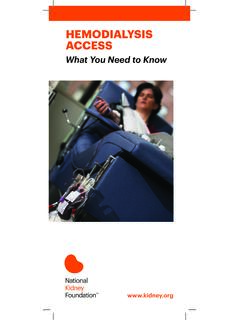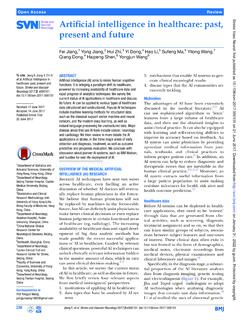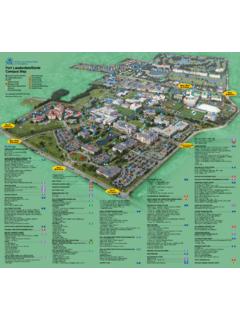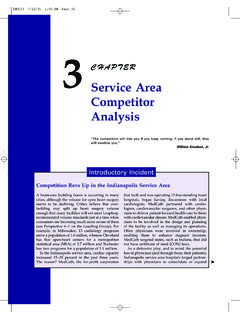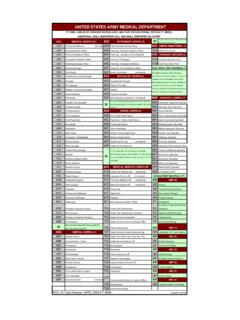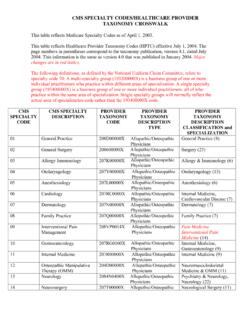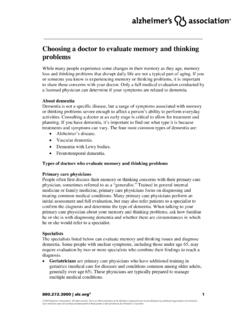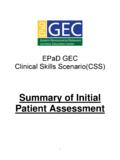Transcription of Covered routine foot care CPT codes - Podiatry
1 Covered routine foot care CPT codes : G0127, 11055, 11056, 11057, 11719, 11720, 11721 While the Medicare program generally excludes routine foot care services from coverage, there are specific indications or exceptions under which there are program benefits. These include: 1. routine foot care when the patient has a systemic disease, such as metabolic, neurologic, or peripheral vascular disease, of sufficient severity that performance of such services by a nonprofessional person would put the patient at risk (for example, a systemic condition that has resulted in severe circulatory embarrassment or areas of desensitization in the patient s legs or feet).
2 2. Treatment of warts on foot is Covered to the same extent as services provided for the treatment of warts located elsewhere on the body. 3. Services normally considered routine may be Covered if they are performed as a necessary and integral part of otherwise Covered services, such as diagnosis and treatment of ulcers, wounds, or infections. 4. Treatment of mycotic nails may be Covered under the exceptions to the routine foot care exclusion. The class findings, outlined below, or the presence of qualifying systemic illnesses causing a peripheral neuropathy, must be present. (Treatment of mycotic nails for patients without systemic illnesses may also be Covered and are defined in a separate local coverage determination (LCD) for Debridement of Mycotic Nails) The following physical and clinical findings, which are indicative of severe peripheral involvement, must be documented and maintained in the patient record, in order for routine foot care services to be reimbursable.
3 The presumption of coverage is applied when the physician rendering the routine foot care has identified either (1) the Class A finding (Q7); (2) two of the Class B findings (Q8); or (3) one Class B and two Class C findings, in addition to a primary condition (Q9). Class A findings: Non-traumatic amputation of foot or integral skeletal portion thereof Class B findings: Absent posterior tibial pulse Advanced trophic changes as evidenced by any three of the following: o hair growth (decrease or increase) o nail changes (thickening) o pigmentary changes (discoloring) o skin texture (thin, shiny) o skin color (rubor or redness) Absent dorsalis pedis pulse Class C findings: Claudication Temperature changes ( , cold feet) Edema Paresthesias (abnormal spontaneous sensations in the feet) Burning Note.
4 Information on the potential coverage and billing for those diabetic patients with severe peripheral neuropathy involving the feet, but without vascular impairment, may be found at: Medicare National Coverage Determinations Manual-Pub. 100-03, Chapter 1, Section and Medicare Claims Processing Manual-Pub. 100-04, Chapter 32, Sections Diagnoses codes with an * require the date last seen by an MD/DO. Lepromatous leprosy (type l) Tuberculoid leprosy (type t) Indeterminate leprosy (group i) Borderline leprosy (group b) Other specified leprosy Leprosy unspecified Madura foot Gas gangrene 042 HIV disease Acute polio w/other paralysis Postherpetic polyneuropathy West Nile fever Lyme disease Tabes dorsalis General paresis Syphilitic meningitis Syphilitic encephalitis Syphilitic parkinsonism Neurosyphilis unspecified Dermatophytosis of nail *- Secondary diabetes mellitus * mellitus w/o comp * w/hyperosmolarity * renal manifest * neuro manifest * circulatent manifest * unspec manifestation * other * Pellagra Lipidoses Amyloidosis.
5 Unspecified Familial mediterranean fever Other amyloidosis * Pernicious anemia Other blood diseases Encephalitis unspec Alzheimer's disease Paralysis agitans Myoclonus Huntington's chorea Spinocerebellar disease Spinal muscle atrophy unspec Amyotrophic lateral sclerosis Progressive muscular atrophy 340* Multiple sclerosis CNSs demyelination other Flaccid hemiplegia Infantile cerebral palsy Quadraplegia/quadraparesis Monoplegia lower limb Lumbosacral root les other Other nerve root/plexus disorder Mononeuritis lower limb Hereditary peripheral neuropathy Inflammatory & toxic neuropathy * Acute infective polyneuritis Polyneuropathy in collagen vascular disease * Polyneuropathy in diabetes * Polyneuropathy in malignant disease Polyneuropathy in other diseases classified elsewhere * Alcoholic polyneuropathy * Polyneuropathy due to drugs * Polyneuropathy due to other toxic agents Chronic inflammatory demyelinating polyneuritis Critical illness polyneuropathy Other inflammatory and toxic neuropathy Unspecified inflammatory and toxic neuropathies 436 CVA Hemiplegia unspec side Monoplegia lower limb Other
6 Paralytic syndrome Atherosclerosis Aneurysm artery lower extremity Raynaud's syndrome Thromboangiitis Obliterans (Buerger's disease) Other peripheral vascular dis Lower extremity embolism Iliac artery embolism Arterial embolism other Polyarteritis nodosa * Takayasu's disease Arterial disease other Arterial disease unspec * Phlebitis/Thrombophlebitis Embolism and thrombosis of unspecified site Varicose veins lower extremity Other lymphedema Postphlebetic syndrome Other dis circulatory system Celiac disease Tropical sprue * Chronic kidney disease, stage i * Chronic kidney disease, stage ii (mild) * Chronic kidney disease, stage iii (moderate) * Chronic kidney disease, stage iv (severe)
7 * Chronic kidney disease, stage v * End stage renal disease 700 Corns & callosities Other specified diseases of nail Unspec disease nail Sebaceous cyst Chronic ulcer skin, ankle Chronic ulcer skin, heel Ulcer heel/midfoot Ulcer other * Pain limb * Skin sensation disturb Gangrene * Other nonspec positive culture Open wound toe Open wound toe Contusion toe Crushing injury toe 1st deg burn toe 1st deg burn toe 2nd deg burn toe 2nd deg burn foot 3rd deg burn toe 3rd deg burn foot Deep 3rd deg burn toe Deep 3rd deg burn foot 3rd deg burn w/loss toe 3rd deg burn w/loss foot Anaphylactic shock food Lower leg injury unspec Poison local anti infect Poison loc astringent/detergent Poison emol/demul/protect Frostbite hand Frostbite foot
8 Prophylactic chemotherapy History blood disease History circulatory disorder Sensory problems w/limbs Lower limb amputation status Encounter long anticoag use * for these diagnoses, the patient must be under the active care of a doctor of medicine or osteopathy (MD or DO) or qualified non-physician practitioner for the treatment and/or evaluation of the complicating disease
